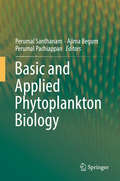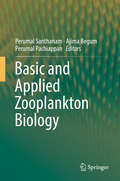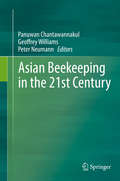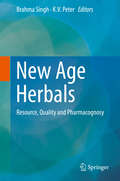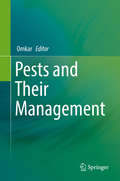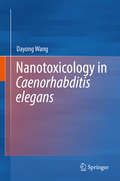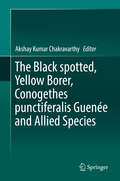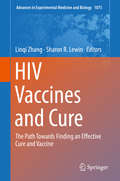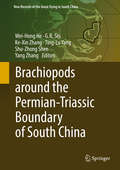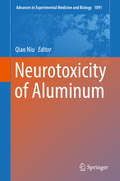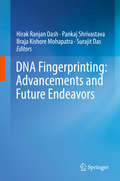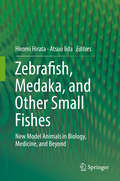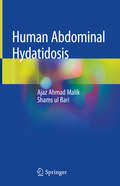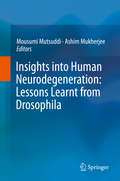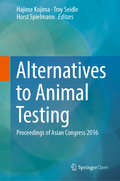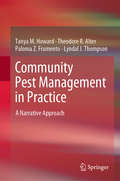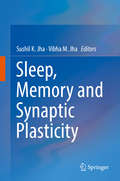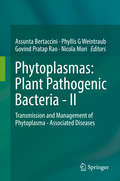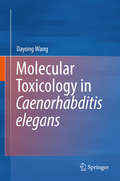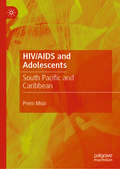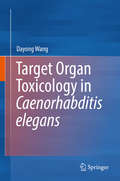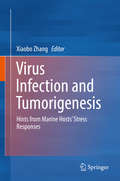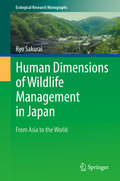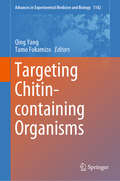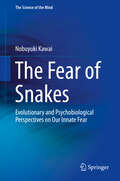- Table View
- List View
Basic and Applied Phytoplankton Biology
by Perumal Santhanam Ajima Begum Perumal PachiappanThis book presents the latest developments and recent research trends in the field of plankton, highlighting the potential ecological and biotechnological applications. It critically and comprehensively discusses strain selection, growth characteristics, large-scale culturing, and biomass harvesting, focusing on the screening and production of high-value products from algae, and evaluating carbon dioxide sequestration from fuel gas as a climate change mitigation strategy. The latter areas of research are clearly central to the sustainable development approach that is currently attracting global attention.Over the decades, much of the literature on has focused on the biological and ecological aspects of phytoplankton found in freshwater, marine and brackish water environments. However, these organisms are known to also inhabit various other environments. More recently, there has been a substantial shift toward the concept of sustainable development and the “green economy” with emphasis on exploiting biological systems for the benefit of mankind. The significance of these plankton cannot be underestimated as they contribute approximately 40% of the oxygen in the atmosphere. Therefore, there is potential for exploitation of this invaluable biomass source that could lead to significant environmental and economic benefits for man.Providing a comprehensive outline of the most recent developments and advances in the field of industrial applications of these plankton, this book is an excellent reference resource for researchers and practitioners.
Basic and Applied Zooplankton Biology
by Perumal Santhanam Ajima Begum Perumal PachiappanThe coastal and ocean ecosystem is a significant feature of our planet and provides a source of food for much of life on Earth. Millions of species have been, and are still being discovered in the world’s oceans. Among these zooplankton serve as secondary producers and are significant as they form pelagic food links and act as indicators of water masses. They constitute the largest and most reliable source of protein for most of the ocean’s fishes. As such, their absence or depletion often affects fishery. In many countries, the decline in fishery has been attributed to reduced plankton populations. Furthermore, trillions of tiny copepods produce countless faecal pellets contributing greatly to the marine snow and therefore accelerating the flow of nutrients and minerals from the surface waters to the seabed. They are phylogenetically highly successful groups in terms of phylogenetic age, number of living species and success of adaptive radiation. A study of the basic and applied aspects of zooplankton would provide an index of the fishery potential and applications, offering insights into ocean ecology to safeguard food supplies and livelihoods of the millions of people living in coastal areas. For this reason, we need to understand all the facets of zooplankton as well as their interactions with atmosphere and other life forms, including human. In this context, this book discusses the basic and applied aspects of zooplankton, especially taxonomy, mosquitocidal activity, culture, analysis of nutritional, pigments and enzyme profile, preservation of copepods eggs, bioenrichment of zooplankton and application of zooplankton in sustainable aquaculture production, focusing on novel biofloc-copefloc technologies, and the impact of acidification and microplastics on zooplankton.Offering a comprehensive overview of the current issues and developments in the field of environmental and commercial applications, this book is a valuable resource for researchers, aquaculturists, environmental mangers wanting to understand the importance of zooplankton and develop technologies for the sustainable production of fish and other commodities to provide food and livelihoods for mankind.
Asian Beekeeping in the 21st Century
by Panuwan Chantawannakul Geoffrey Williams Peter NeumannFrom the perspective of local scientists, this book provides insight into bees and beemanagement of Asia, with a special focus on honey bees.Asia is home to at least nine honey bee species, including the introduced European honeybee, Apis mellifera. Although A. mellifera and the native Asian honey bee, Apis cerana,are the most commonly employed species for commercial beekeeping, the remainingnon-managed native honey bee species have important ecological and economic roleson the continent. Species distributions of most honey bee species overlap in SoutheastAsia, thus promoting the potential for interspecies transmission of pests and parasites,as well as their spread to other parts of the world by human translocation.Losses of managed A. mellifera colonies is of great concern around the world, includingin Asia. Such global colony losses are believed to be caused, in part, by pests andparasites originating from Asia such as the mite Varroa destructor, the microsporidianNosema ceranae, and several bee viruses.Taking advantage of the experience of leading regional bee researchers, this book providesinsight into the current situation of bees and bee management in Asia. Recentintroductions of honey bee parasites of Asian origin to other parts of the world ensuresthat the contents of this book are broadly relevant to bee scientists, researchers, governmentoffi cials, and the general public around the world.
New Age Herbals: Resource, Quality and Pharmacognosy
by Brahma Singh K. V. PeterImportance of herbs (medicinal plants) can hardly be overemphasized. They are exploited for manyfold applications, ranging from phytopharmaceuticals, to nutraceuticals, to cosmetics and many others. Keeping in view the richness of herbs and their vast potential, this book collates the most up-to-date knowledge of important herbs and herbals. The book also gives an overview of some issues causing hindrance in the promotion of herbals. This book attempts to compile the rich experience of experts working on various herbs. New age single plant species, having multiple medicinal traits worth exploiting i.e. Hippophae rhamnoides (seabuckthorn), and Morinda citrifolia (noni) also find place as full chapters in the book.
Pests and Their Management
by OmkarThis book comprehensively compiles information on some of the major pests that afflict agricultural, horticultural and medicinal crops in particular as well as many polyphagous pests. Not only does this book deal with the pests of common globally produced crops it also addresses those of rarely dealt with crops such as seed spices, medicinal and aromatic plants. While the perspective of insect pests is largely Indian and South East Asian in context, the book does deal with globally problematic pests, particularly polyphagous ones. Not only will the readers be acquainted with the pests, their damaging potential and their life cycle but also with the latest methods of managements including ecofriendly measures being employed to keep pest populations at manageable levels. The 27 chapters in the book, are grouped into four sections primarily based on crop types, viz. pest of agricultural, horticultural and medicinal crops, and polyphagous pests, making the book easy to navigate. Each of the chapters is comprehensive and well illustrated and written by academicians who have dedicated their entire lives to the study of a particular crop-pest complex. The final chapter of this book provides an overview on the principles and processes of pest management.
Nanotoxicology in Caenorhabditis elegans
by Dayong WangThis book focuses on the toxicity of engineered nanomaterials (ENMs) and their underlying physicochemical, cellular, physiological, and molecular mechanisms. Further, it covers ENMs’ translocation and their targeted organ toxicology, and discusses chemical and pharmacological strategies used to combat nanotoxicity. Engineered nanomaterials (ENMs) are defined as materials with one or more dimensions of less than 100 nm, and have shown considerable promise in several areas of development. At the same time, the potential toxicity of ENMs for human health and environmental organisms is increasingly attracting attention. In addition to the typical properties of model animals, Caenorhabditis elegans is extremely sensitive to environmental toxicants, which makes it the ideal in vivo assay system for toxicological studies. C. elegans has been widely used in toxicity assessment and toxicological studies of environmental toxicants and stresses. This book provides a comprehensive summary of nanotoxicology research on C. elegans.
The Black spotted, Yellow Borer, Conogethes punctiferalis Guenée and Allied Species
by Akshay Kumar ChakravarthyConogethes is a group of moths distributed in Austral-Asian region from India to New Guinea, the Solomon Islands and Australia.The moths are also found in Hawaii and Great Britain. Conogethes is mostly known for the economic impact of its larvae on agricultural crops. Substantial research has been undertaken in order to understand the biology of these harmful insects and to develop strategies to confine their impact. Research on chemical communication between males and females via sex pheromones is in progress.Recent research has also focused on the acoustic communication of Conogethes. The moths can feed on more than 200 plants in diversified habitats. The borer moths have become major pest on Horticultural , Agricultural,Avenue trees and forest trees. Its a pest of Quarantine importance as it has been found in Exportable commodities. The book contains 22 chapters from a dozen countries. The authors are from China, Vietnam, Australia, Sri Lanka, Malaysia, Norway etc. This is the first book on the pest globally where interesting insights are provided. This is one of the book of its kind on single pest dealing with almost all aspects of its biology and management on cultivated crops.
HIV Vaccines and Cure: The Path Towards Finding an Effective Cure and Vaccine (Advances in Experimental Medicine and Biology #1075)
by Linqi Zhang Sharon R. LewinThis book provides a comprehensive review of the major barriers to HIV cure and vaccine. It covers the fundamental virology and immunology leading to HIV transmission, protection from infection and long term HIV persistence on antiretroviral therapy. In addition, strategies being tested to eliminate persistent HIV and the rational design of vaccines to induce protective immunity are covered. This book also discusses the challenges related to the design of clinical trials for testing the safety and efficacy of these innovative approaches. This book will provide a systematic overview and also discuss controversial issues for researchers in virology and immunology, as well as practicing physicians, and scientists in the pharmaceutical industry.
Brachiopods around the Permian-Triassic Boundary of South China (New Records Of The Great Dying In South China Ser.)
by Wei-Hong He G. R. Shi Ke-Xin Zhang Ting-Lu Yang Shu-Zhong Shen Yang ZhangThis timely book documents marvelous brachiopod fossils from the Palaeozoic-Mesozoic transition of South China. Numerous beautiful pictures and detailed descriptions (specifically the measurements of body size) of brachiopod species are presented. Systematic discussion on the evolution of brachiopod biodiversity and morphological features across the critical interval is not only extremely important for paleontologists to understand the marine ecosystem evolution from the Palaeozoic to the Mesozoic, but also attractive for students who need to know about the end-Permian mass extinction. The book distinguishes itself from other studies by its detailed study of the taxonomy, biodiversity and paleoecology of Permian-Triassic brachiopods from different palaeogeographic facies, especially from the deep-water environment in South China. The book also offers a unique study of the response of morphological features of brachiopods to palaeoenvironmental changes, providing insights for the process of Permian-Triassic crisis.
Neurotoxicity of Aluminum (Advances in Experimental Medicine and Biology #1091)
by Qiao NiuThis book reviews the scientific literature and the authors’ own research linking aluminum neurotoxicity with cognitive impairment and Alzheimer’s disease (AD). It focuses on aluminum levels in the brain, region-specific and subcellular distribution, and its relation to neurofibrillary tangles and amyloid beta. Further, the book stresses the importance of aluminum’s complex speciation chemistry in relation to biology, and details aluminum’s mechanism in oxidative stress and cell death, especially in connection with apoptosis and necroptosis. The electrophysiological variation and synaptic plasticity induced by aluminum are covered, while the metal’s debatable role in AD and the cross-talk between aluminum and genetic susceptibility are also discussed. In closing, the book reviews the neurotoxic effects of aluminum and its important role in the pathogenesis of AD. Given its depth of coverage, the book provides readers with a systematic summary of aluminum neurotoxicity.
DNA Fingerprinting: Advancements and Future Endeavors
by Hirak Ranjan Dash Pankaj Shrivastava Braja Kishore Mohapatra Surajit DasThis book describes the basics and various applications of DNA fingerprinting, including in actual case studies. The book is divided in four modules; Module 1: Basics of DNA Fingerprinting, Module 2: Applications of DNA Fingerprinting, Module 3: DNA Fingerprinting: Case Studies, and Module 4: Future of DNA Fingerprinting. Each module consists of 4 to 5 chapters, written by reputed researchers, academics and forensic scientists from around the globe. The respective chapters cover e.g. related fields, the tools and techniques used, various genotyping kits, real-world case studies, ancient DNA and wild life forensics, molecular diagnosis of human diseases, legal aspects, microbial forensics and the economics of the DNA fingerprinting technique. The book offers a practical guide for professionals, graduate and post-graduate students in the fields of Forensic Science, Medicine, Genetics, Anthropology, Microbiology, and Zoology. It also serves as a useful reference resource, summarizing major technological advances in the field of DNA fingerprinting, the problems faced in this field of science and possible new solutions to these problems. Presently, DNA fingerprinting is utilized in solving the majority of criminal cases; as such, the book is also helpful for investigating agencies, as it includes representative case studies.
Zebrafish, Medaka, and Other Small Fishes: New Model Animals in Biology, Medicine, and Beyond
by Hiromi Hirata Atsuo IidaThis book provides cutting-edge studies and technologies using small fishes, including zebrafish, medaka, and other fishes as new model animals for molecular biology, developmental biology, and medicine. It also introduces eccentric fish models that are pioneering new frontiers of biology.Zebrafish and medaka have been developed as lower vertebrate model organisms because these small fish are easy to raise in the laboratory and are useful for the live imaging of the morphology and activity of cells and tissues in intact animals. By virtue of those specific advantages, fish studies have demonstrated the common features of vertebrates and raised further questions toward understanding the mystery of life.The book consists of four parts: “Development and Cell Biology”, “Homeostasis and Reproduction”, “Clinical Models”, and “Eccentric Fish”. Together they describes the core area of small fish study – often considered mere zoology but which is actually proving to be the universal basis of life.Written by leading scientists, the book helps readers to understand small fishes, inspires scientists to utilize small fishes in their studies, and encourages anyone who wants to participate in the large and fantastic world of small fish.
Human Abdominal Hydatidosis
by Ajaz Ahmad Malik Shams Ul BariThe book explores various aspects of hydatid disease, including the background, parasitology, epidemiology, etiology, pathogenesis and presentation in humans. It features dedicated chapters on hydatidosis of liver, spleen, peritoneum, kidney, pelvis, and disseminated hydatid disease, and also provides detailed information on the latest surgical and non-surgical methods for treating the condition, such as drug therapy and laproscopic management. The book is primarily intended for undergraduate and postgraduate students of surgery and medicine, but is also useful to veterinary science students and pharmaceutical companies. Further, it serves as a valuable reference resource for academics and researchers in associated fields.
Insights into Human Neurodegeneration: Lessons Learnt from Drosophila
by Mousumi Mutsuddi Ashim MukherjeeThis book is aimed at generating an updated reservoir of scientific endeavors undertaken to unravel the complicated yet intriguing topic of neurodegeneration. Scientists from Europe, USA and India who are experts in the field of neurodegenerative diseases have contributed to this book. This book will help readers gain insight into the recent knowledge obtained from Drosophila model, in understanding the molecular mechanisms underlying neurodegenerative disorders and also unravel novel scopes for therapeutic interventions. Different methodologies available to create humanized fly models that faithfully reflects the pathogenicities associated with particular disorders have been described here. It also includes information on the exciting area of neural stem cells. A brief discussion on neurofibrillary tangles, precedes the elaborate description of lessons learnt from Drosophila about Alzheimer's, Parkinson’s, Spinomuscular Atrophy, Huntington’s diseases, RNA expansion disorders and Hereditary Spastic Paraplegia. We have concluded the book with the use of Drosophila for identifying pharmacological therapies for neurodegenerative disorders. The wide range of topics covered here will not only be relevant for beginners who are new to the concept of the extensive utility of Drosophila as a model to study human disorders; but will also be an important contribution to the scientific community, with an insight into the paradigm shift in our understanding of neurodegenerative disorders. Completed with informative tables and communicative illustrations this book will keep the readers glued and intrigued. We have comprehensively anthologized the lessons learnt on neurodegeneration from Drosophila and have thus provided an insight into the multidimensional aspects of pathogenicities of majority of the neurodegenerative disorders.
Alternatives to Animal Testing: Proceedings of Asian Congress 2016
by Hajime Kojima Troy Seidle Horst SpielmannThis open access book presents recent advances in the pure sciences that are of significance in the quest for alternatives to the use of animals in research and describes a variety of practical applications of the three key guiding principles for the more ethical use of animals in experiments – replacement, reduction, and refinement, collectively known as the 3Rs. Important examples from across the world of implementation of the 3Rs in the testing of cosmetics, chemicals, pesticides, and biologics, including vaccines, are described, with additional information on relevant regulations. The coverage also encompasses emerging approaches to alternative tests and the 3Rs. The book is based on the most informative contributions delivered at the Asian Congress 2016 on Alternatives and Animal Use in the Life Sciences. It will be of value for those working in R&D, for graduate students, and for educators in various fields, including the pharmaceutical and cosmetic sciences, pharmacology, toxicology, and animal welfare. The free, open access distribution of Alternatives to Animal Testing is enabled by the Creative Commons Attribution license in International version 4: CC BY 4.0.
Community Pest Management in Practice: A Narrative Approach
by Tanya M. Howard Theodore R. Alter Paloma Z. Frumento Lyndal J. ThompsonThis book presents a collection of practitioner and community stories that reveal how invasive species management is a community issue that can spark community formation and collective action. It combines the unique first-person narratives of practitioners on the frontline of invasive species management in Australia with three case studies of community action for wild dog management across a range of geographical landscapes. The book offers readers a new understanding of how communities are formed in the context of managing different species, and how fundamental social and political processes can make or break landholders’ ability to manage invasive species. Using narrative analysis of practitioner profiles and community groups, drawing lessons from real-world practices, and employing theories from community development, rural sociology and collective action, this book serves multiple functions: it offers a teaching tool, a valuable research contribution, and a practitioner’s field guide to pursuing effective community development work in connection with natural resource management, wildlife management and environmental governance.
Sleep, Memory and Synaptic Plasticity
by Sushil K. Jha Vibha M. JhaOver the years there has been growing interest among the scientific community in investigating sleep and how it affects the memory and other brain functions. It is now well established that sleep helps in memory consolidation and induction of neural plasticity, and that short-term deprivation of either total sleep or rapid eye movement sleep alone can induce memory deficits very quickly. Quantitative and qualitative changes in sleep architecture after different training tasks further suggest that discrete memory types may require specific sleep stage/s for optimal memory consolidation, and studies indicate that sleep deprivation alters synaptic plasticity and membrane excitability in the hippocampal neurons and synaptic up-scaling in the cortical neurons. Further, sleep alteration during pregnancy may increase the risk of depression and adversely affect maternal-child relationships, parenting practices, family functioning, and children's development and general wellbeing. This book coherently discusses all these aspects, with a particular focus on the possible role of sleep in memory consolidation and synaptic plasticity. It also highlights the detrimental effects of sleep loss on mental health, the immune system and cognition.This book is a valuable reference resource for students and researchers working in the area of sleep, memory, or neuronal plasticity.
Phytoplasmas: Transmission and Management of Phytoplasma - Associated Diseases
by Assunta Bertaccini Phyllis G Weintraub Govind Pratap Rao Nicola MoriPhytoplasma-associated diseases are a major limiting factor in the context of the quality and productivity of many ornamental, horticultural and other economically important agricultural crops worldwide. Annual losses due to phytoplasma diseases vary, but under pathogen-favorable conditions they have disastrous consequences for the farming community. As there is no effective cure for these diseases, the management options focus on their exclusion, minimizing their spread by insect vectors and propagation materials and on the development of host plant resistance.This book discusses the latest information on the epidemiology and management of phytoplasma-associated diseases, providing a comprehensive, up-to-date overview of distribution, occurrence and identification of the phytoplasmas, recent diagnostics approaches, transmission, losses and geographical distribution as well as management aspects.
Molecular Toxicology in Caenorhabditis elegans
by Dayong WangThis book will focus on the molecular basis of oxidative stress induced by toxicants or stresses and various molecular signalling pathways in regulating the toxicity of toxicants or stresses in Caenorhabditis elegans. It will also cover the discussion on the aspects of response signals, G-protein coupled receptors and ion channels, specific molecular signals, and epigenetic signals involved in the regulation of toxicity from toxicants or stresses. The molecular basis for adaptive response for transgenerational toxicity of environmental toxicants or stresses will be further discussed. Nematode Caenorhabditis elegans is a classic model animal with well-described genetic and developmental backgrounds based on the study of life science, and has been further successfully and widely used in both toxicity assessment and toxicological study of various environmental toxicants or stresses. Based on related available data, this book aims at providing a systematic understanding of the knowledge system of molecular toxicology in C. elegans.
HIV/AIDS and Adolescents: South Pacific and Caribbean
by Prem MisirThis book addresses the relationship between high school students’ HIV and AIDS knowledge and their stigma-related attitudes/perceptions of people living with HIV (PLHIV) in the Caribbean and South Pacific, with a view to designing effective stigma-reduction combined intervention programs. Presenting an international cross-sectional study using a purposive sample of high school students from Fiji (South Pacific), Vanuatu (South Pacific), Guyana, and Antigua & Barbuda (Caribbean) to assess HIV and AIDS knowledge and stigma-related attitudes by gender, age, religion, race/ethnicity, and socioeconomic status, the book shows how stigmatizing attitudes and beliefs negatively impact interventions to prevent and treat HIV and AIDS.
Target Organ Toxicology in Caenorhabditis elegans
by Dayong WangThis book introduces readers to intestinal and epidermal barriers, and to toxicity induction of environmental toxicants or stresses in the intestine, epidermis, neurons, muscle, and reproductive organs in Caenorhabditis elegans. In addition, it discusses the protective responses of various organs and nematodes’ avoidance behaviour with regard to environmental toxicants or stresses. The intestinal, epidermal, neuronal, and germline signalling pathways required for the regulation of toxicity of environmental toxicants or stresses are also introduced and discussed. As a classic model animal with well-described genetic and developmental backgrounds, the nematode Caenorhabditis elegans has been successfully and widely used in both toxicity assessments and toxicological studies on various environmental toxicants and stresses. Once exposure to certain environmental toxicants has occurred, the toxicants can enter into the primary targeted organs (such as intestinal cells), and even be translocated into secondary targeted organs (such as reproductive organs and neurons). Based on related available data, this book provides a systematic understanding of target organ toxicology in C. elegans.
Virus Infection and Tumorigenesis: Hints from Marine Hosts’ Stress Responses
by Xiaobo ZhangThis book reviews the latest research on the molecules and mechanisms of marine host stress responses to viral infections and tumorigenesis. It offers an overview of the state of the art in the field as well as future directions. Metabolism disorder is a characteristic of tumorigenesis. Since viruses complete their life cycle in host cells, such infections cause metabolic disorders in the host. As such, the mechanisms of virus pathogenesis and tumor progression are similar or even identical. In essence, the role of antiviral molecules is to maintain the metabolic homeostasis of infected host cells, and the antiviral molecules induced by virus infection may play an important role in antitumor pathways, resulting in cancer cell death or restoring the disordered metabolism of cancer cells. The molecules generated during host stress responses to viruses can also contribute to the antitumor mechanisms in humans. However, the relationship between host stress responses to virus infection and tumorigenesis has not been extensively explored. In recent years, studies have shown that marine host stress responses to viral invasion can be good models for exploring human antitumor mechanisms. Stimulating further research in the field, this book offers graduate students and researchers with comprehensive insights into host stress responses to viral invasion and tumor progression. It is also a valuable resource for those working in the pharmaceutical industry interested in drug discovery based on molecules derived from host stress responses to viral infection.
Human Dimensions of Wildlife Management in Japan: From Asia to the World (Ecological Research Monographs)
by Ryo SakuraiThis book discusses the findings of research on the human dimensions of wildlife management conducted in Japan, demonstrating how such research and approaches have contributed to mitigating human-wildlife conflicts.Human-wildlife conflicts, including agricultural and property damage as well as occasional casualties, are a global problem for which local residents, managers, and stakeholders around the world are struggling to find solutions. Human dimensions of wildlife management (HDW) is an academic field developed in North America in the 1970s to gather information on the social aspects of human-wildlife issues to help wildlife managers and stakeholders implement effective decision-making measures. However, HDW is not widely recognized or applied outside North America, and few studies have investigated whether HDW approaches would be effective in different cultural settings.This is the first book written in English to introduce the HDW theories and practices implemented in Asia. Presenting innovative approaches and research techniques, as well as tips on how to introduce HDW methods into culturally different societies, it is a valuable resource not only for researchers and students in this field, but also for government officials/managers, NGOs, residents and other stakeholders who are affected by human-wildlife conflicts around the globe.
Targeting Chitin-containing Organisms (Advances in Experimental Medicine and Biology #1142)
by Qing Yang Tamo FukamizoThis book provides a comprehensive overview of chitin biology and chitin metabolism related enzymes. Chitin, the second most abundant biopolymer in nature after to cellulose, is a linear biopolymer composed of β-1,4-linked N-acetylglucosamine (GlcNAc), and an essential component in the exoskeletons of insects, mites, ticks and crustaceans, the egg shells of parasitic nematodes, and fungal cell walls. Although some chitin-containing organisms are a threat to human health, food safety and agricultural production, non-chitin containing organisms like humans, mammals and plants have an innate immune response to these hazardous organisms. The book provides researchers and students with information on the recent research advances concerning the biology of chitin-containing organisms as well as cross-talks between chitin-containing and non-chitin-containing organisms. Highlighting chitin remodeling enzymes and inhibitors, it also offers drug developers essential insights into designing specific molecules for the control of hazardous chitin-containing organisms.
The Fear of Snakes: Evolutionary and Psychobiological Perspectives on Our Innate Fear (The Science of the Mind)
by Nobuyuki KawaiThis book provides a series of compelling evidence that shows that humans have innate fear of snakes. Building on the previous studies on the Snake Detection Theory (SDT), the author presents a summary of psychological and neuropsychological experiments to explain the fear of snakes in humans and primates. Readers will come to understand why and how we are afraid of snakes from an evolutionary perspective.The first half of the book discusses the history of psychological behaviorism and neobehaviorism. The latter half of the book consists mainly of the experimental studies performed by the author with a focus on three key items: First, compared with other animals, snakes especially draw the attention of primates and humans. Second, the ability of primates and humans to recognize snakes with particular efficiency. Third, processing mechanisms within the brain for snake detection is discussed from a new viewpoint.The book offers a unique resource for all primatologists, psychologists, neuroscientists, anthropologists, herpetologists, and biologists who are interested in the evolution of visual and cognitive systems, mechanisms of fear, snakes or primates.
